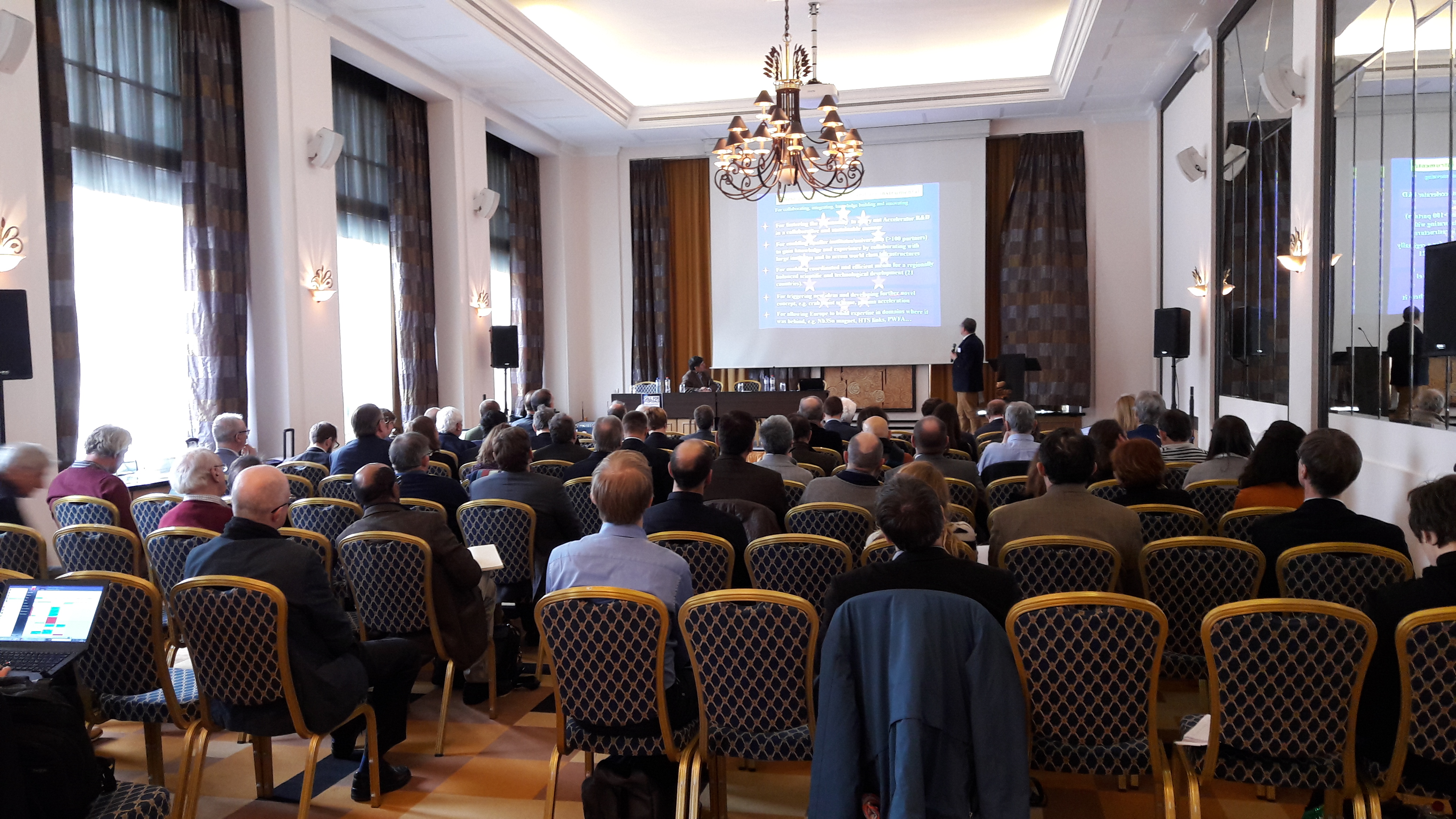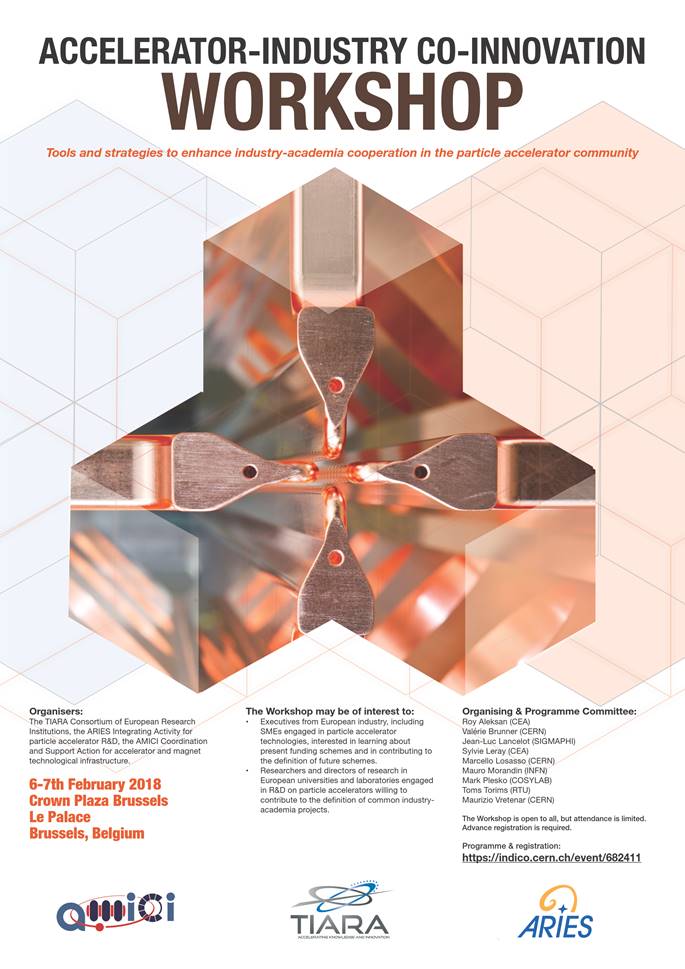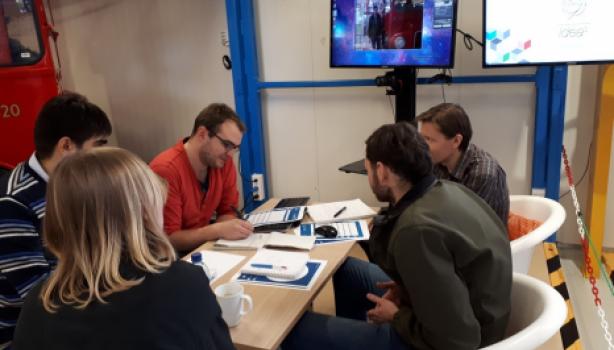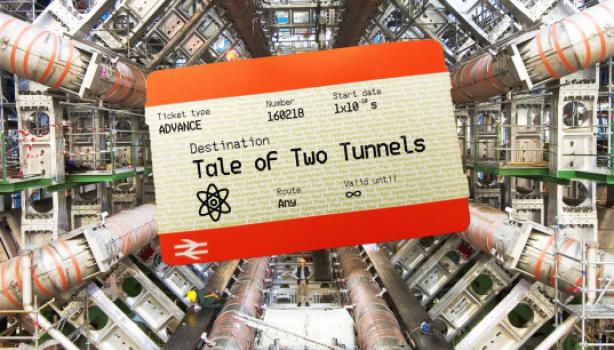The particle accelerator community is increasingly engaged with industry, for the development of the critical components that will power the next generation of accelerators and in a joint effort to bring down to society the benefits from the technologies developed for the past generation of accelerators. Physicists have been inventing new types of accelerators to drive charged particles to higher and higher energies for more than 80 years and it looks like they are not running out of ideas. In parallel, more and more accelerators went to fields such as energy, industry and healthcare where is installed the vast majority of the 40,000 accelerators estimated to be in operation around the world.
More than 90 representatives of scientific institutions, industry and European Commission programmes met for the “Enhancing co-innovation with industry in the Particle Accelerator Community” workshop. Credit: Valérie Brunner .
Industry is increasingly becoming a key partner in these processes. To define instruments and tools to structure and foster industry participation to accelerator development programmes, a well-attended Workshop was organised by three teams engaged in the development of particle accelerators. The TIARA consortium of European research institutions in the Particle Accelerator Research Area, the ARIES Integrating Activity project for accelerator R&D and the AMICI project for support to accelerator and magnet technological infrastructures joined efforts to bring to Brussels for two days in February more than 90 representatives of scientific institutions, industry and European Commission programmes. The Workshop that went under the title of “Enhancing co-innovation with industry in the Particle Accelerator Community” gave a unique opportunity to people coming from different horizons and experiences to discuss issues and to develop a common language, with the goal of creating a community around the main actors of the development of accelerator technology and of the related technology infrastructure.

Meeting on Accelerator-Industry Co-Innovation Workshop, 6-7 February 2018, Brussels - Credit: Valérie Brunner
During the meeting, many presentations highlighted the long way that we have come through to reach the present status of accelerator technologies. The collaboration between European research infrastructures and the industry has been seminal for the realization of unprecedented scientific endeavours. José Manuel Perez on behalf of the TIARA consortium stressed the importance of developing a consistent collaborative programme for Accelerator Science and Technologies as well as the need to further integrate the industrial partners from the beginning onwards of the design of research infrastructures. In the following talk Maurizio Vretenar, ARIES project coordinator, highlighted the broader goals for this event. He emphasized that a project like ARIES promotes accelerator R&D but at the same time will create an academia-industry community around common R&D activities, contribute in developing novel applications for accelerators and finally help the research community to meet the market needs and come closer with the industry. He added: “as we are all part of the same socioeconomic system, it is our interest to help companies develop their business around accelerators and extend the reach of accelerator technology”. An additional dimension was brought in by Olivier Napoly, AMICI project coordinator, who highlighted the importance for industry and for the accelerator community of the vast technological infrastructure of the accelerator laboratories, whose sustainability is a priority goal for Europe.
Successful projects in the framework of FP6, FP7 and H2020 have enabled to integrate the European expertise for collaborative accelerator R&D. Philippe Froissard, Deputy Head of the EC Research Infrastructures (RI) Unit, discussed some of the lessons gained from H2020. “Many industries through involvement in public RIs can validate and produce reliable and standardized results while public procurement for RIs should be used to boost innovation in industry”. Innovation ecosystems can be developed around RIs and is important to think of efficient mechanisms to facilitate knowledge and technology transfer. Finally, he stressed the need to “set roadmaps in key technologies for the construction and upgrade of the pan European network of research infrastructures in order to maximize the benefits for the research community and society as a whole”.
On the second day of this event, representatives from industry shared lessons and their thoughts on how joint R&D projects could be a win-win opportunity for industry. Representatives from ASG, Bruker, Oxford Instruments, SigmaPhi and Elytt, four of the key companies developing magnets for accelerators, shared their experience of collaborating with different research centres. Working with research centres offers unique opportunities for R&D and innovation but also certain challenges given the discontinuity in R&D projects. Designing long-term large-scale research infrastructures represent the best chance for setting a new frame of co-innovation.
Finally, Riko Wichmann, head of the XFEL Project Office in DESY discussed the lessons learned from XFEL. The challenging technology of superconductivity required a strong collaborative effort between researchers and the industry while knowledge transfer has been challenging and often more time-consuming than expected.
With the active support from the European Commission, accelerator laboratories and projects are joining efforts with industry to propel accelerator technology into the next decade. This was the first in a series of events that aim to advance a rigorous collaboration with industry and consequently maximise the impact that accelerators have for science and society.



